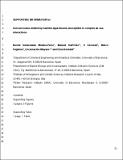Por favor, use este identificador para citar o enlazar a este item:
http://hdl.handle.net/10261/229839COMPARTIR / EXPORTAR:
 SHARE SHARE
 CORE
BASE CORE
BASE
|
|
| Visualizar otros formatos: MARC | Dublin Core | RDF | ORE | MODS | METS | DIDL | DATACITE | |

| Título: | Aerosol toxins emitted by harmful algal blooms susceptible to complex air-sea interactions |
Autor: | Medina-Pérez, Noemí Inmaculada CSIC ORCID; Dall'Osto, Manuel CSIC ORCID CVN ; Decesari, S.; Paglione, Marco; Moyano, Encarnación; Berdalet, Elisa CSIC ORCID | Fecha de publicación: | ene-2021 | Editor: | American Chemical Society | Citación: | Environmental Science and Technology 55(1): 468-477 (2021) | Resumen: | Critical research is needed regarding harmful algal blooms threatening ecosystem and human health, especially through respiratory routes. Additional complexity comes from the poorly understood factors involved in the physical production of marine aerosols coupled with complex biogeochemical processes at ocean surfaces. Here—by using a marine aerosol generation tank—five bubble-bursting experiments (with contrasting incubation times and, likely, physiological microalgal states) were run to investigate simultaneously the concentrations of the toxins, synthesized by a natural Ostreopsis cf. ovata bloom, in suspension in the water and in the atmosphere. The first two experiments (EXP1–2) were run with moderate levels of O. cf. ovata cell numbers (ca. 105 cells·L–1) and total toxin in suspension (4 × 106 pg·Lwater–1) obtained at an early phase of the bloom. After 0.75–4 h incubation, toxin concentration in the aerosols accounted for 49–69 pg·Lair–1. By striking contrast, three experiments (EXP3–5)—conducted with samples collected two weeks later with higher cell abundances and higher toxin concentration in the seston (respectively, about 1 × 106 cells·L–1 and 2 × 108 pg·Lwater–1) and incubated for 21 h—showed about 15-fold lower atmospheric concentrations (3–4 pg·Lair–1), while important foam accumulation was observed in the water surface in the tank. Offline spectroscopic analysis performed by proton-nuclear magnetic resonance spectroscopy showed that the particulate organic carbon in the water was drastically different from that of bubble-bursting aerosols from the tank experiments—suggesting a selective transfer of organic compounds from seawater into the atmosphere. Overall, the results suggest that aerosol production and diffusion of marine toxins in the atmosphere are regulated by complex interactions between biological processes and air-sea aerosol production dynamics | Descripción: | 10 pages, 4 figures, supporting information https://doi.org/10.1021/acs.est.0c05795 | Versión del editor: | https://doi.org/10.1021/acs.est.0c05795 | URI: | http://hdl.handle.net/10261/229839 | DOI: | 10.1021/acs.est.0c05795 | Identificadores: | issn: 0013-936X e-issn: 1520-5851 |
| Aparece en las colecciones: | (ICM) Artículos |
Ficheros en este ítem:
| Fichero | Descripción | Tamaño | Formato | |
|---|---|---|---|---|
| Medina_et_al_2021_preprint.pdf | 559,55 kB | Adobe PDF |  Visualizar/Abrir | |
| Medina_et_al_2021_suppl.pdf | 252,05 kB | Adobe PDF |  Visualizar/Abrir |
CORE Recommender
SCOPUSTM
Citations
24
checked on 28-abr-2024
WEB OF SCIENCETM
Citations
21
checked on 29-feb-2024
Page view(s)
143
checked on 12-may-2024
Download(s)
401
checked on 12-may-2024
Google ScholarTM
Check
Altmetric
Altmetric
NOTA: Los ítems de Digital.CSIC están protegidos por copyright, con todos los derechos reservados, a menos que se indique lo contrario.
